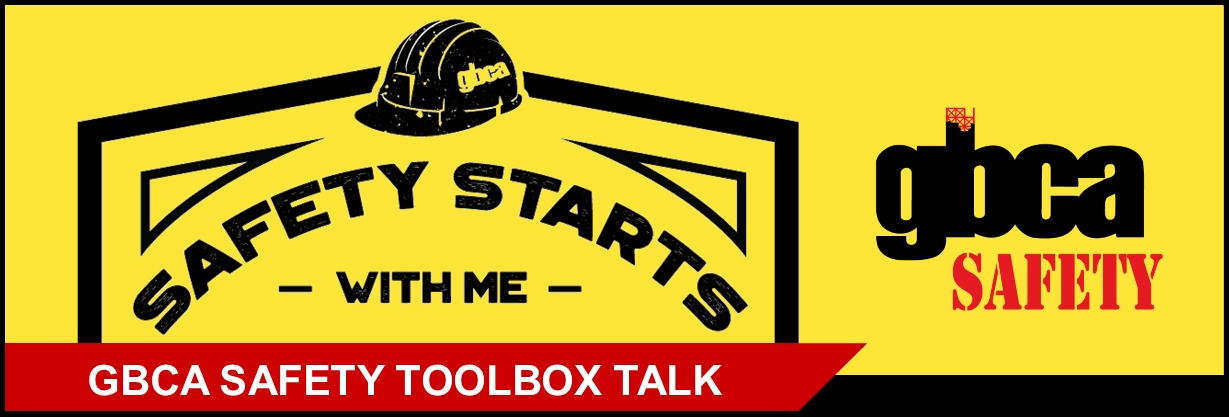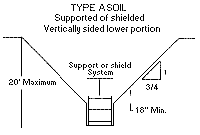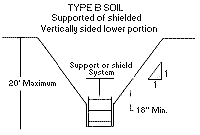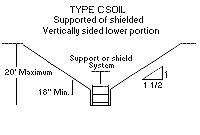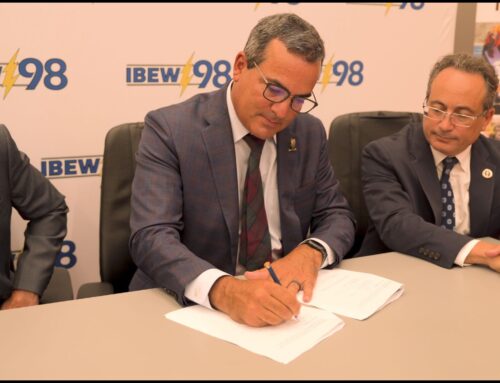This GBCA Safety Toolbox Talk discusses shielding and shoring, two protective systems to prevent cave-ins in excavation and trenching activities. Click below to download the Toolbox Talk as a multi-page handout.
Trenching and Excavation: Shielding and Shoring
Introduction
Excavation and trenching are among the most hazardous construction operations. The Occupational Safety and Health Administration’s (OSHA) Excavation standards, 29 Code of Federal Regulations (CFR) Part 1926, Subpart P, contain requirements for excavation and trenching operations.
PROTECTIVE SYSTEMS: HOW TO PREVENT CAVE-INS
OSHA generally requires that employers protect workers from cave-ins. Two methods covered in this toolbox talk at shoring and shielding.
Shoring refers to supporting the sides of the excavation.
Shoring Types
Shoring is the provision of a support system for trench faces used to prevent movement of soil, underground utilities, roadways, and foundations. Shoring or shielding is used when the location or depth of the cut makes sloping back to the maximum allowable slope impractical. Shoring systems consist of posts, wales, struts, and sheeting. There are two basic types of shoring, timber and aluminum hydraulic.
Timber Shoring
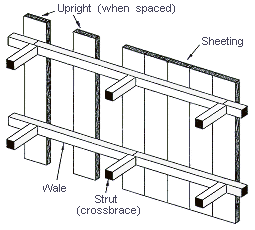
This figure (above) illustrates an example of timber shoring, including various parts such as sheeting, crossbrace struts, uprights, and wales. The crossbrace struts connect to the wales, which provide support to the sheeting and uprights.
Hydraulic Shoring
The trend today is toward the use of hydraulic shoring, a prefabricated strut and/or wale system manufactured of aluminum or steel. Hydraulic shoring provides a critical safety advantage over timber shoring because workers do not have to enter the trench to install or remove hydraulic shoring. Other advantages of most hydraulic systems are that they:
- Are light enough to be installed by one worker;
- Are gauge-regulated to ensure even distribution of pressure along the trench line;
- Can have their trench faces “preloaded” to use the soil’s natural cohesion to prevent movement; and
- Can be adapted easily to various trench depths and widths.
All shoring should be installed from the top down and removed from the bottom up. Hydraulic shoring should be checked at least once per shift for leaking hoses and/or cylinders, broken connections, cracked nipples, bent bases, and any other damaged or defective parts.
Shoring Variations: Typical Aluminum Hydraulic Shoring Installations
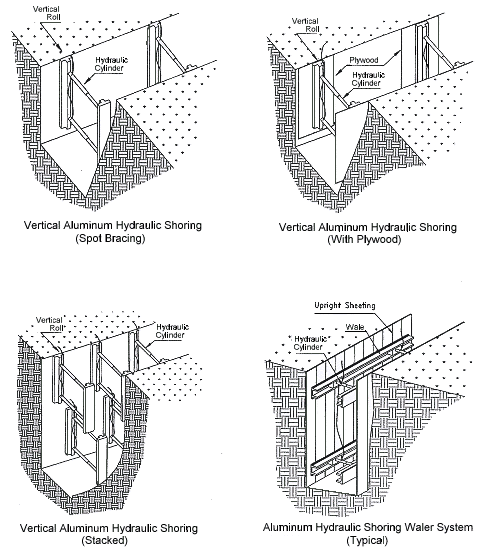
This figure (above) illustrates four vertical aluminum hydraulic shoring variations: Vertical Aluminum Hydraulic Shoring with Spot Bracing, Vertical Aluminum Hydraulic Shoring with Plywood, Vertical Aluminum Hydraulic Shoring (Stacked), and Aluminum Hydraulic Shoring Water System (Typical). The first variation uses a hydraulic cylinder to exert force against a vertical roll, which transfers the force the the wale. The second variety adds plywood between the vertical roll and wale. The third variety stacks multiple arrangements of the first type vertically. The fourth variety uses a hydraulic cylinder exerting force on a horizontal wale that presses against upright sheeting.
Pneumatic Shoring
Pneumatic shoring works in a manner similar to hydraulic shoring. The primary difference is that pneumatic shoring uses air pressure in place of hydraulic pressure. A disadvantage to the use of pneumatic shoring is that an air compressor must be on site.
- Screw Jacks. Screw jack systems differ from hydraulic and pneumatic systems in that the struts of a screw jack system must be adjusted manually. This creates a hazard because the worker is required to be in the trench in order to adjust the strut. In addition, uniform “preloading” cannot be achieved with screw jacks, and their weight creates handling difficulties.
- Single-Cylinder Hydraulic Shores. Shores of this type are generally used in a water system, as an assist to timber shoring systems, and in shallow trenches where face stability is required.
- Underpinning. This process involves stabilizing adjacent structures, foundations, and other intrusions that may have an impact on the excavation. As the term indicates, underpinning is a procedure in which the foundation is physically reinforced. Underpinning should be conducted only under the direction and with the approval of a registered professional engineer.
Shoring Variations
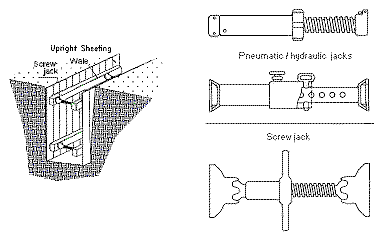
This figure (above) has a diagram showing the various components of upright sheeting, along with pneumatic/hydraulic jacks and a screw jack. The various jacks press up against the wale, which in turn keep the shoring in position.
Shielding is when you place a shield between the side of the excavation and the work area.
Shielding Types
Trench Boxes are different from shoring because, instead of shoring up or otherwise supporting the trench face, they are intended primarily to protect workers from cave-ins and similar incidents. The excavated area between the outside of the trench box and the face of the trench should be as small as possible. The space between the trench boxes and the excavation side are backfilled to prevent lateral movement of the box. Shields may not be subjected to loads exceeding those which the system was designed to withstand.
This figure (below) illustrates a trench shield, consisting of a knife edge, sidewall, and struts. The knife edge is at the bottom edge of the sides of the trench shield, and struts are going between both sides of the shield, providing support.
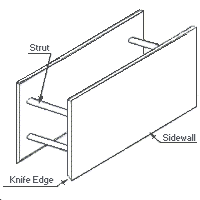
This figure (below) illustrates two trench shields, stacked upon each other.
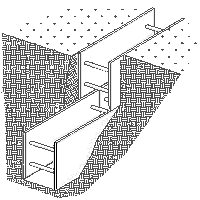
Combined Use. Trench boxes are generally used in open areas, but they also may be used in combination with sloping and benching.
Earth excavation to a depth of 2 ft (0.61 m) below the shield is permitted, but only if the shield is designed to resist the forces calculated for the full depth of the trench and there are no indications while the trench is open of possible loss of soil from behind or below the bottom of the support system. Conditions of this type require observation on the effects of bulging, heaving, and boiling as well as surcharging, vibration, adjacent structures, etc., on excavating below the bottom of a shield. Careful visual inspection of the conditions mentioned above is the primary and most prudent approach to hazard identification and control.
All excavations 20 feet or less in depth which have vertically sided lower portions that are supported or shielded shall have a maximum allowable slope of ¾:1. The support or shield system must extend at least 18 inches above the top of the vertical side.
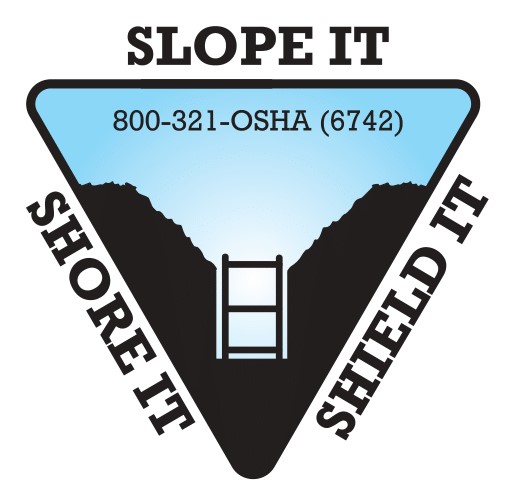
Remember to record the attendees of your toolbox talk!
Access GBCA’s full library of toolbox talks:

